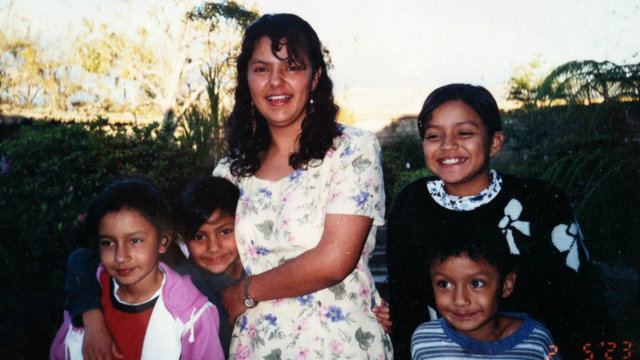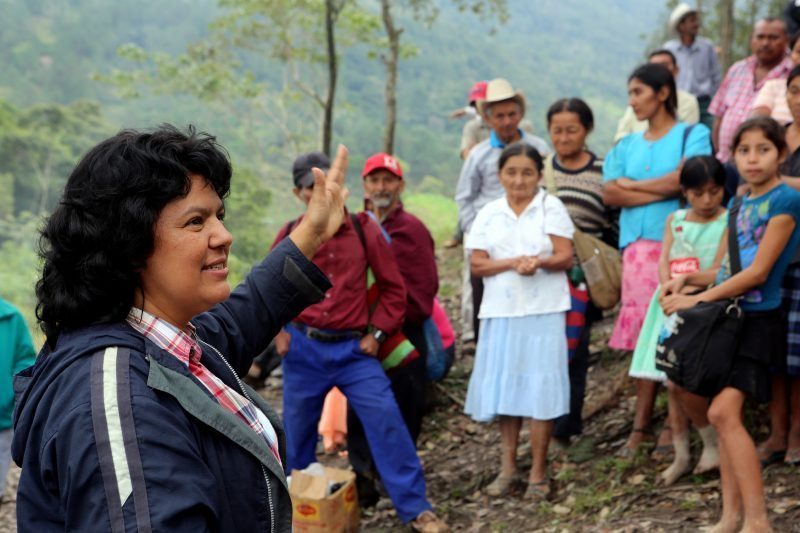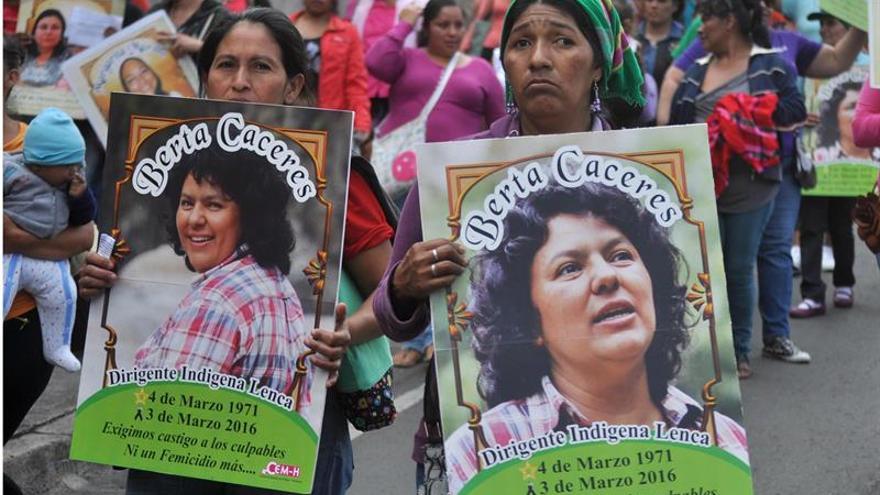Judi Lynn
Judi Lynn's JournalFamily of slain Honduran activist appeal to US court for help in her murder trial
The children of Berta Cáceres want to subpoena bank records to a luxury house purchased by the alleged mastermind of the murder
Nina Lakhani
Sat 31 Aug 2019 03.00 EDT
The children of murdered Honduran activist Berta Cáceres have applied to a US federal court to subpoena bank records linked to a $1.4m luxury house in Texas purchased by the alleged mastermind of the crime just months after the killing.
Cáceres, 44, a winner of the prestigious Goldman prize for environmental defenders, was shot dead at her home by a hired gunmen on 2 March 2016 after a long battle to stop construction of an internationally financed hydroelectric dam on the Gualcarque river, which the Lenca people consider sacred.
In November 2018, seven men were convicted of carrying out the murder, which the court in Tegucigalpa ruled was ordered by executives of the Agua Zarca dam company Desa because of delays and financial losses linked to protests led by Cáceres.
One of the executives identified in court was David Roberto Castillo Mejía, the CEO of Desa. In March 2018 Castillo was indicted as an “intellectual author”, who is alleged to have coordinated with, and provided funds to, the killers. He vehemently denies any involvement.
More:
https://www.theguardian.com/world/2019/aug/31/berta-caceres-murder-trial-subpoena-david-castillo?CMP=Share_AndroidApp_Copy_to_clipboard&fbclid=IwAR1Hhh11wVWDfa7S56vEUEMnOc-sJXxMGNB9JXJLSmJ6edI_xqkCIy0e9bo

Berta Cáceres, as a young mother with her children





David Roberto Castillo Mejía, the CEO of Desa
List of worker deaths in United States labor disputes
This is all important information to at least scan, to refresh memories, awaken people to the fact men and women gave their lives trying to improve working conditions in the U.S. after others were being worked to death, exploited beyond all reasoning by greed-driven sociopaths determined to become more powerful, wealthier than everyone else in their lifetimes, to grab, use up everything in reach before laws could be written to prevent their crimes:
~ ~ ~
From Wikipedia, the free encyclopedia
The following list of worker deaths in United States labor disputes captures known incidents of fatal labor-related violence in U.S. labor history, which began in the colonial era with the earliest worker demands around 1636 for better working conditions. It does not include killings of enslaved persons. According to a study in 1969, the United States has had the bloodiest and most violent labor history of any industrial nation in the world, and there have been few industries which have been immune.[1]
This list is not comprehensive. A number of factors (multi-sided conflicts, physically remote locations, company-controlled locations, exaggerated or biased original reporting, etc.) make some of the death and injury counts uncertain.
More:
https://en.wikipedia.org/wiki/List_of_worker_deaths_in_United_States_labor_disputes
The Troubling Relationships Between Bolsonaro and Dictatorships
AUGUST 30, 2019
by RAPHAEL TSAVKKO GARCIA
When he was a congressman, the walls of Brazilian president Jair Bolsonaro’s office were decorated with photos of Brazilian dictators. Bolsonaro has repeatedly defended the Brazilian military dictatorship that ruled from 1964 to1985. He even paid homage to the Chilean dictator, Augusto Pinochet. In an interview in 2015, Bolsonaro said that Pinochet “had to act violently to recover the country” and, on several occasions, stated that the dictator “did what had to be done” and that he “should have killed more people”.
It was no surprise that thousands of Chileans took to the streets to protest his visit to the country last March. Chilean politicians refused to meet him, and even President Sebastián Piñera consideredhis statements in support of the dictator “unfortunate”. Recently, Bolsonaro also expressed admiration for the dictator (also rapist and paedophile) General Stroessner of Paraguay.
Historian Murilo Cleto keeps a mental registry of Bolsonaro’s views of the past. “When Brazil erected a statue in honour of Rubens Paiva, a state representative kidnapped by the military in 1971 whose body has not yet been found, Bolsonaro went to the event to spit on it. In reference to the relatives of the guerrilla fighters killed and disappeared in the Araguaia, Bolsonaro said ‘those who look for bone are dogs’. To Matheus Leitão, son of journalist Miriam Leitão, who was placed pregnant, naked and alone with a snake in a dark room of an army battalion, Bolsonaro said he felt sorry for the snake,” Murillo Cleto recalled.
A former Army Capitan, Bolsonaro is also a confessed admirer of Colonel Carlos Alberto Brilhante Ustra, one of the heads of torture centres during the military dictatorship. In a speech during a visit to Israel last month, Bolsonaro once again praised the torturer while also stating that Nazism would be a left-wing ideology.
More:
https://www.counterpunch.org/2019/08/30/the-troubling-relationships-between-bolsonaro-and-dictatorships/
Also posted in Editorials and other articles:
https://www.democraticunderground.com/1016238437
A Warming Climate Threatens Archaeological Sites in Greenland
As temperatures rise and ice melts, Norse and Inuit artifacts and human remains decompose more rapidly

The site of Brattahlid, the eastern settlement Viking colony in southwestern Greenland founded by Erik the Red near the end of the 10th century A.D. (Werner Forman / Universal Images Group via Getty Images)
By Lucas Joel, Eos
smithsonian.com
August 30, 2019
In Norse mythology, there are many myths that once known, are now lost. But the Norse, of course, left behind more than their tales. They also left behind their things and, in places like Anavik, on the western coast of Greenland, their dead.
And long before Vikings came to Greenland, the indigenous Inuit people left behind mummies, as well as hair with intact DNA.
Elsewhere in the Arctic, on an icy island called Spitsbergen, there’s a place called the Corpse Headlands, where there are graves filled with the bodies of 17th and 18th century whalers. When archeologists excavated the site in the 1970s, they found down-filled pillows, mittens, and pants sewn together from pieces of other pants.
The Arctic’s ice helps preserve these snippets of human history. But snippets of organic material rot when it’s hot, and new research is finding that as the world warms, remains like those at Anavik and Corpse Headlands will decompose before archaeologists are ever able to unearth them.
Read more: https://www.smithsonianmag.com/science-nature/warming-climate-threatens-archaeological-sites-greenland-180973021/#fQCoMczbjwP74p8F.99
The Last 14 Loa Water Frogs Had to Be Rescued From Their Natural Habitat
The lone Chilean stream where the frogs live had been dried up by illegal water extraction

A Loa water frogs rescued near the city of Calama, Chile. (Ministry of Housing and Urbanism of Chile)
By Brigit Katz
smithsonian.com
August 30, 2019
In June of this year, herpetologist Andrés Charrier took some of his colleagues to view the Loa water frog, a small and speckled critter that dwells exclusively in a stream outside the Chilean city of Calama. But upon arriving at the site, the group found that the stream was dry—and the population of water frogs, already critically endangered, seemed to have shrunk to just 14 sickly individuals that languished in a pool of muddy water.
“It’s something we talk about all the time—frogs are at risk, animals and the environment are at risk, climate change and drought, extreme weather conditions,” Charrier tells Megan Shersby of BBC Wildlife. “But I have been working in conservation for the last 10 years with frogs and I never expected to see something like this.”
The team, which consisted of conservationists, government officials and indigenous leaders, knew that time for the Loa water frog, or Telmatobius dankoi, was running out fast. So they collected the paltry group of surviving individuals and transported them to the National Zoo of Chile—with the hope of eventually launching a breeding program.
Some 63 species of the genus Telmatobius can be found across South America, making their homes in such countries as Chile, Ecuador, Bolivia and Argentina. Like the Loa water frog, most Telmatobius species are microendemic, meaning that their range is restricted to a single, small location. This in turn makes them highly vulnerable to changes to their habitat; in fact, according to Sabrina Imbler of Atlas Obscura, the majority of recognized Telmatobius are endangered.
Read more: https://www.smithsonianmag.com/smart-news/last-14-loa-water-frogs-had-be-rescued-their-natural-habitat-180973023/#z8ErJlPjGQE3rc5j.99
Donald Trump: Full up to the eyeballs with hate. He won on that once, and hopes to do it again
Trump is certainly a racist bigot, but the evil runs deeper: No previous president has been so driven by hate
LUCIAN K. TRUSCOTT IV
AUGUST 31, 2019 12:00PM (UTC)
Let’s go back and have a look at the early days of Trump’s campaign for president the last time around and see what it tells us about this time. Trump announced he was running for president on June 16, 2015. After famously descending the Trump Tower escalator with his wife, Melania, Trump went right after Mexicans and immigrants. “They’re bringing crime, they are rapists,” he bellowed to the first crowd of his formal campaign for president. He promised to build a “great wall” along the border with Mexico to keep them out. His crowd howled their approval. So the racism and the xenophobia were there right from the start. He would expand on both with his promised “Muslim ban.” He quickly held rallies in New Hampshire, Arizona and South Carolina, where he repeated the themes to crowds screaming for more.
A month later he was at something called the “Family Leadership Summit,” a gathering of conservatives in Ames, Iowa. Trump gratuitously mocked Sen. John McCain as a “loser,” telling his conservative audience, “He was a war hero because he was captured. I like people who weren’t captured.” He was quickly denounced by Republican Party leaders. Former Texas Gov. Rick Perry — also a presidential candidate at the time —said Trump was “unfit to be commander in chief.” Republican National Committee strategist and chief spokesman Sean Spicer announced, “There is no place in our party or our country for comments that disparage those who have served honorably.” Jeb Bush tweeted, “Enough with the slanderous attacks.”
“It is unclear how the remarks by Trump, who currently is at or near the top in opinion polls, measuring the popularity of the sprawling field of Republican presidential contenders, will be received by party stalwarts, many of whom are staunch supporters of the military,” NPR reported later the same day.
But it was clear how his attack would go over. Trump’s campaign responded by pointing out that “Mr. Trump left to a long lasting standing ovation, which will be by far the biggest ovation of the weekend, and much congratulatory praise."
What was going on with Trump’s seemingly gratuitous, out-of-the-blue slander of a United States senator and war hero? Clearly, Trump hated McCain. It was extraordinary that Trump gave voice to his hate in such a prominent, public way. But what was even more extraordinary was the reaction to it.
More:
https://www.salon.com/2019/08/31/donald-trump-full-up-to-the-eyeballs-with-hate-he-won-on-that-once-and-hopes-to-do-it-again/
Profile Information
Member since: 2002Number of posts: 160,527